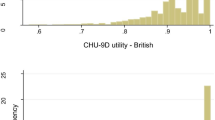Abstract
Feasibility, reliability, and discriminative validity of the cross-culturally adapted Dutch version of the originally US child health questionnaire-child form (CHQ-CF87), an 87-item generic pediatric health-related quality of life instrument, were assessed. The success criterion in this first evaluation was the equivalence of psychometric properties of the adapted and the original CHQ. A total of 466 schoolchildren (9–17 years) were invited to complete the questionnaire in the classroom. Test–retest reliability was measured after 14 days in a subgroup (n = 71). Response was 96%. Four scales had ceiling effects (> 50%), as was reported in an Australian study. Cronbach α-values were adequate (> 0.70), except for ‘physical functioning’ (0.56). Test–retest correlations, not previously reported, were not statistically significant for two CHQ-scales, whereas average retest scores indicated better health for five scales (p < 0.01). The CHQ scales discriminated significantly (p < 0.01) between children without (n = 281) and children with two or more self-reported chronic diseases (n = 59). This is in correspondence with US and Australian reports. Conclusions: The current data support application of the Dutch CHQ-CF in predominantly healthy populations, e.g. in school settings. Given the limitations of this study and some less favorable results (score distributions, internal consistency; test–retest reliability), further evaluation of the CHQ-CF is recommended, preferably by analyses of item performance and scale validity in international data sets that include varied clinical subgroups.
Similar content being viewed by others
References
Landgraf JM, Abetz L, Ware JE. The CHQ User's Manual. Boston: The Health Institute, New England Medical Center, 1996.
Landgraf JM, Abetz LN. Functional status and well-being of children representing three cultural groups: Initial selfreports using the CHQ-CF87. Psychol Health 1997; 12: 839-854.
Landgraf JM, Maunsell E, Speechley KN, et al. Canadian-French, German and UK versions of the child health questionnaire: Methodology and preliminary item scaling results. Qual Life Res 1998; 7(5): 433-445.
Landgraf JM. Measuring pediatric outcomes in applied clinical settings: An update about the child health questionnaire (CHQ). Quality of Life Newsletter MAPI Research Institute 1999; (23): 5-6.
Ruperto N, Ravelli A, Pistorio A, et al. Cross-cultural adaptation and psychometric evaluation of the childhood health assessment questionnaire (CHAQ) and the child health questionnaire in 32 countries. Review of the general methodology. Clinical and Experimental Rheumatology 2001; 19(4 (Suppl. 23)): S1-S9.
Raat H, Bonsel GJ, Essink-Bot ML, Landgraf JM, Gemke RJ. Reliability and validity of comprehensive health status measures in children. The child health questionnaire in relation to the health utilities index. J Clin Epidemiol 2002; 55(1): 67-76.
Kurtin PS, Landgraf JM, Abetz L. Patient-based health status measurements in pediatric dialysis: Expanding the assessment of outcome. Am J Kidney Dis 1994; 24(2): 376-382.
Sawyer MG, Spurrier N, Whaites L, Kennedy D, Martin AJ, Baghurst P. The relationship between asthma severity, family functioning and the health-related quality of life of children with asthma. Qual Life Res 2000; 9(10): 1105-1115.
Cunningham JM, Chiu EJ, Landgraf JM, Gliklich RE. The health impact of chronic recurrent rhinosinusitis in children. Arch Otolaryngol Head Neck Surg 2000; 126(11): 1363-1368.
Perwien AR, Johnson SB, Silverstein JH. Quality of life assessment in youth with type I diabetes: Use of a brief generic measure. In: 7th Annual Conference of the International Society for Quality of Life Research, 2000, Canada: Vancouver, Quality of Life Research, 2000; p. 281.
Legetic B, Kvrgic S, Niciforovic-Surkovic O. Quality of life among school children and youth in Yugoslavia-child-parent differences. In: 7th Annual Conference of the International Society for Quality of Life Research, 2000, Canada: Vancouver; Quality of Life Research, 2000; 9 p. 298.
Waters EB, Salmon LA, Wake M, Wright M, Hesketh KD. The health and well-being of adolescents: Aschool-b ased population study of the self-report child health questionnaire. J Adolesc Health 2001; 29(2): 140-149.
Anderson RT, Aaronson NK, Bullinger M, McBee WL. A review of the progress towards developing health-related quality-of-life instruments for international clinical studies and outcomes research. Pharmacoeconomics 1996; 10(4): 336-355.
Guillemin F, Bombardier C, Beaton D. Cross-cultural adaptation of health-related quality of life measures: Literature review and proposed guidelines. J Clin Epidemiol 1993; 46(12): 1417-1432.
Ware JE Jr, Keller SD, Gandek B, Brazier JE, Sullivan M. Evaluating translations of health status questionnaires. Methods from the IQOLAproject. International Quality of Life Assessment. Int J Technol Assess Health Care 1995; 11(3): 525-551.
Bland JM, Altman DG. Cronbach's a. Br Med J 1997; 314 (7080): 572.
Deyo RA, Diehr P, Patrick DL. Reproducibility and responsiveness of health status measures. Statistics and strategies for evaluation. Control Clin Trials 1991; 12(Suppl 4): 142S-158S.
Cohen J. Statistical power analysis for the behavioral sciences. New York: Academic Press; 1977.
Author information
Authors and Affiliations
Corresponding author
Rights and permissions
About this article
Cite this article
Raat, H., Landgraf, J., Bonsel, G. et al. Reliability and validity of the child health questionnaire-child form (CHQ-CF87) in a Dutch adolescent population. Qual Life Res 11, 575–581 (2002). https://doi.org/10.1023/A:1016393311799
Issue Date:
DOI: https://doi.org/10.1023/A:1016393311799



